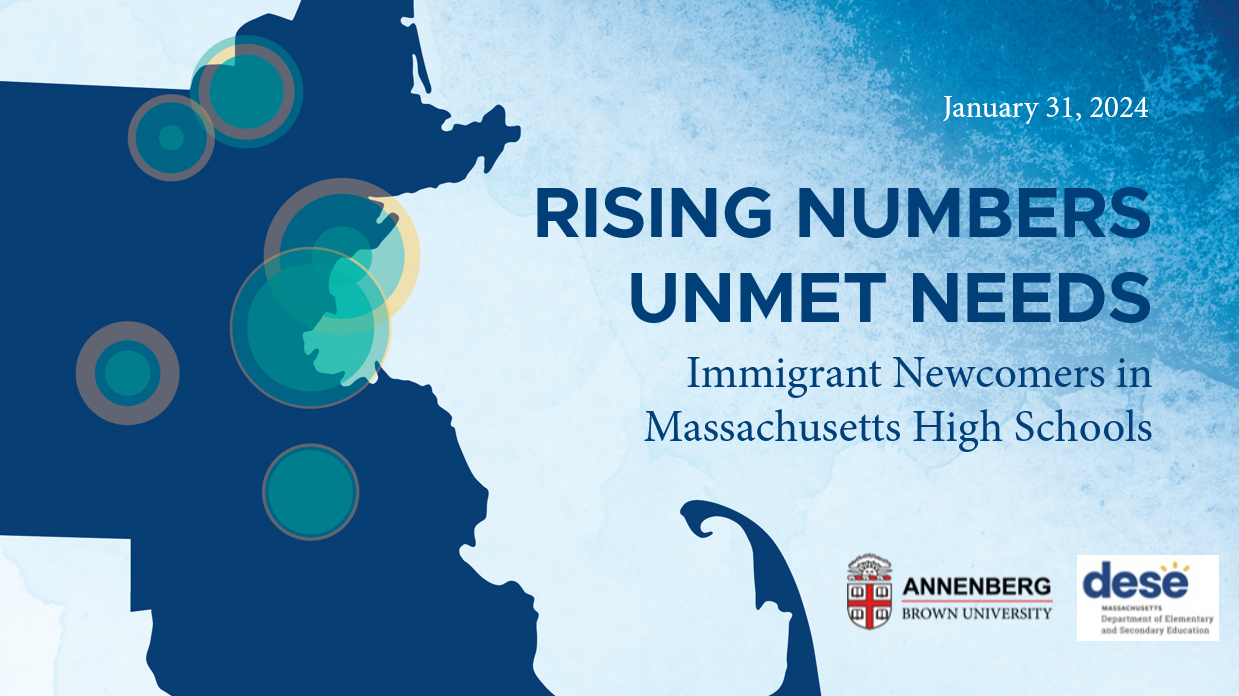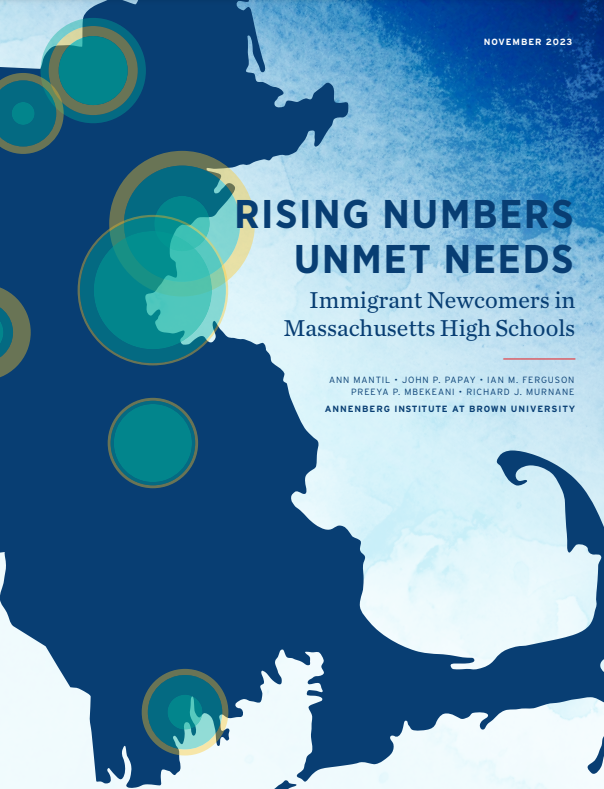Rising Numbers, Unmet Needs: Immigrant Newcomers in Massachusetts High Schools
January 31, 2024
Javier Juarez, Director of the Latino Equity Fund at the Boston Foundation, welcomed the audience to the Edgerley Center for Civic Leadership on January 31st, 2024, with a challenge – to strengthen the way the city welcomes new immigrant students.
“There is no other way to say it, this is the definition of an intersectional topic,” Juarez said. “It will take all of us to move the needle for the betterment of our newcomer community who need us now more than ever before.”
The remarks kicked off a forum centered on Rising Numbers, Unmet Needs: Immigrant Newcomers in Massachusetts High Schools, a report from the Annenberg Institute at Brown University that was released in October, but updated for the event with new numbers from 2022 and 2023.
Dr. Ann Mantil, Senior Research Associate at the Annenberg Institute, shared the six key findings of their research:
- Over the past 15 years, the number of newcomers has nearly tripled and the population has changed dramatically.
- More districts are serving newcomers, but newcomers are concentrated in relatively few schools.
- The profiles of newcomers differ dramatically across districts.
- Most newcomers are not meeting growth targets for English language proficiency.
- The Commonwealth’s competency determination (CD) policy disproportionately affects newcomers.
- High-school completion and college enrollment rates for newcomers are relatively low.
With a short interruption from the COVID-19 pandemic, the number of immigrant newcomers in Massachusetts high schools has steadily increased over the past two decades, with about 13% of newcomers in Boston public schools and 60% in other urban districts around the Commonwealth. Case in point: in 2008, Lynn high schools had 88 newcomers. By 2022, that number increased to 602.
Supporting those newcomers to succeed academically is a challenge, particularly when it comes to the MCAS, which is only offered in English (and in some tests, Spanish). During the pandemic, the MCAS was suspended as a requirement, and the newcomer graduation rate rose. Newcomers also lag other students in college enrollment and completion.
Mantil ended her presentation highlighting another set of challenging issues for improving those numbers.
- Patterns in where newcomers come from and where they enroll are very dynamic, even within a individual years
- Newcomers continue to be concentrated in urban districts, but more districts are enrolling newcomers than ever before
- Newcomers arrive in Massachusetts with very different levels of schooling, depending on their countries of origin, further underlining the need for customized supports and interventions
Commissioner Jeff Riley of the Massachusetts Department of Elementary and Secondary Education, who spoke next, was no stranger to these challenges, having served as Superintendent and Receiver of Lawrence Public Schools.
“We had the systems and structures set up to receive the children. We know what to do in some of these other places. We have to provide technical support to make sure that our kids get what they need. It is complicated. It is not always a one-size-fits-all model.”
And he acknowledged the gap between language needs for students and testing requirements. “Our newcomer high school students are not meeting growth targets for ELA proficiency. The research says it takes newcomers more time to learn a language. If we know it takes five to seven years to learn a language, yet the federal government says we have to test them after one year, how do you square that circle? How do you think differently about that?”
Moderator Dr. John Papay, Director of the Annenberg Institute and Associate Professor of Education and Economics at Brown University, then welcomed four distinguished panelists to the stage: Dr. Carola Suarez-Orozco, Professor in Residence at the Harvard Graduate School of Education, and Director of the Immigration Initiative at Harvard University, Allison Balter, Director of the Office of Language Acquisition at the Massachusetts Department of Elementary and Secondary Education, Rania Caldwell, Director of Multilingual Learners at Woburn Public Schools, and Dr. Almi Abeyta, Superintendent of Chelsea Public Schools.


Agenda
Welcome
Javier Juarez, Director, Latino Equity Fund at the Boston Foundation
Presentation of the Report
Dr. Ann Mantil, Senior Research Associate, Annenberg Institute
Remarks
Jeffrey C. Riley, Commissioner, MA Dept. of Elementary and Secondary Education
Panel Discussion and Q&A
Dr. John Papay, Director, Annenberg Institute; Associate Professor of Education and Economics, Brown University (Moderator)
Dr. Carola Suarez-Orozco, Professor in Residence, Harvard Graduate School of Education; Director, Immigration Initiative at Harvard
Allison Balter, Director, Office of Language Acquisition, MA Dept. of Elementary and Secondary Education
Rania Caldwell, Director of Multilingual Learners, Woburn Public Schools
Dr. Almi Abeyta, Superintendent, Chelsea Public Schools
Closing Remarks
Javier Juarez, Director, Latino Equity Fund at the Boston Foundation
The experts discussed their reactions to the report. For Dr. Suarez-Orozco, it brought up multiple questions such as Are the goals realistic? Are the measures accurate assessments of their skills? Are the services provided adequate for newcomers to meet their goals? And are these one-size-fits-all goals realistic?
Dr. Suarez-Orozco continued, recognizing that, with the current system, many students feel discouraged coming into a school with lower-level English skills, and are getting feedback, almost immediately, that they are not good enough.
Caldwell spoke to her own experience as an educator coming into Woburn Public Schools. She recalls a press release coming out the day after she started, announcing a hundred newcomers. At the time, the school system was not prepared to meet the needs of those students. “Newcomers are concentrated in some spaces, but many districts receiving newcomers do not have those systems and structures,” Caldwell said. “What do we need to do to make sure it’s consistent across the Commonwealth?”
To Balter,a former prinicipal of a newcomer high school program, the report addresses a long-needed but often overshadowed conversation.
“We have not been able to have this conversation in the same way before, and for a very technical reason. We do not have a specific state or federal definition of the word ‘newcomers’ as a subgroup. People use that term to mean very different things, but we don’t actually have to report on that for accountability purposes. So often the needs of newcomers get eclipsed in the larger conversations about English learners as a whole.”
As a principal, Balter was often left frustrated because she wanted productive conversations about how to advocate for and support newcomers so they could reach their goals, but often could not because there was not sufficient data.
Dr. Papay then directed the conversation to practical solutions for these unmet needs. “Where do we go from here to better serve newcomers?”
Dr. Abeyta observed that before newcomers have their academic needs met, they need their most essential needs met, referencing Maslow’s Hierarchy of Needs. “We have to think, as a community, how are we supporting our newcomers? It is not just up to the schools to carry the burden. The community has to come and support, and that’s exactly what we’ve been able to do in Chelsea. That’s why I love working in Chelsea because we come together as a community.”
She suggested organizing communities at the state level as a path forward, especially as more students arrive with a need for legal supports.
Balter recognized the vital role the Department of Secondary Education plays in developing solutions, connecting districts that have historically been serving newcomers with those who are just starting to serve them. She references the Office of Language Acquisition with their SLIFE Community of Practice, with over 50 districts joining together, doing site visits, and building a toolkit of resources for in-need students.
Additionally, Balter stated the need to amplify student voices. “High school students have really powerful ideas. They can tell you what is working for them. They can tell you what is not working for them. They can tell you if they feel safe in a learning environment, [and] what makes them feel unsafe. They can tell you what practices their teachers are doing that are effective for their learning,” she said. “It is not going to be a one-size-fits-all model, and so we really do need to be talking to the students as the primary consumers, the primary stakeholders here to understand ‘what is it that you need? What is going to help you reach your outcomes?’”
The forum closed with a powerful story from Javier Juarez, who had opened the event. He shared his experience as an undocumented newcomer, being told by a counselor that college was likely out of reach, but he should look into landscaping. “I felt a little ashamed that I could not become something of myself due to a social security number,” Juarez said. “I think I felt this way because she did not see my potential as a young person, a person with dreams and goals.” Now, as Director of the Latino Equity Fund at the Boston Foundation, Juarez recognizes the need for educators to provide accurate and helpful information to newcomers to lead them on the best path possible after high school. “I’m not a petty person, but I wish she was here today, and she could hear me introduce the work of my alma mater.”
